Key takeaways:
- Horses primarily communicate through body language, including ear positions and posture, which reveal their emotional states.
- Our own energy and emotions can influence a horse’s behavior, highlighting the importance of remaining calm during interactions.
- Building trust with horses requires a willingness to empathize, acknowledge their feelings, and create structured routines.
- Patience and understanding are crucial in training, as allowing space for horses to express themselves can lead to stronger connections.
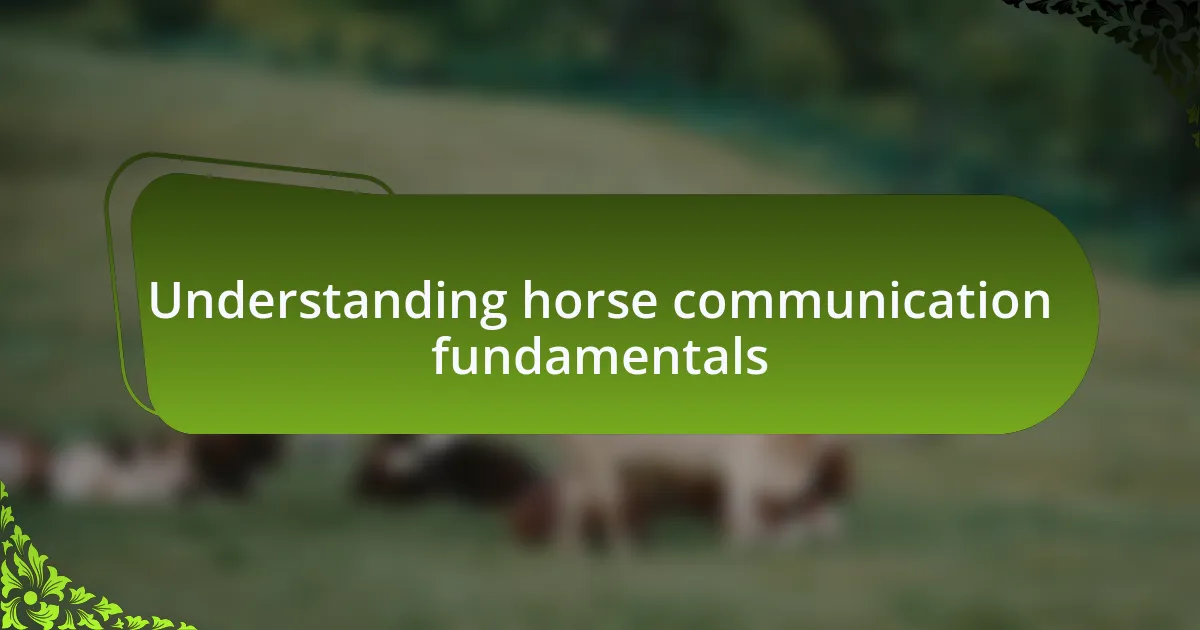
Understanding horse communication fundamentals
Understanding the fundamentals of horse communication is essential for building a deep bond with these magnificent creatures. Horses communicate primarily through body language, using subtle postures, ear positions, and tail movements to convey their feelings. I remember the first time I recognized a horse’s discomfort—its ears pinned back and a tense posture. It was a stark reminder that paying attention to these signals can make all the difference.
When I first began working with horses, I often underestimated their ability to express emotions. I remember a moment with a mare who seemed standoffish; her flicking tail and lowered head spoke volumes. This made me wonder: how many of us truly take the time to interpret these cues? Understanding that a horse’s mood can change with its environment is crucial. It requires a willingness to observe and reflect on the nuances of their expressions.
Another fundamental I learned is that horses respond to our energy levels and emotions. One day, I was nervous before a ride, and I could feel my horse mirroring that tension. It hit me hard—our feelings can influence their behavior. Have you ever noticed how your mood can affect your interactions with your horse? By managing our energy and remaining calm, we can foster a trusting relationship that benefits both horse and rider.
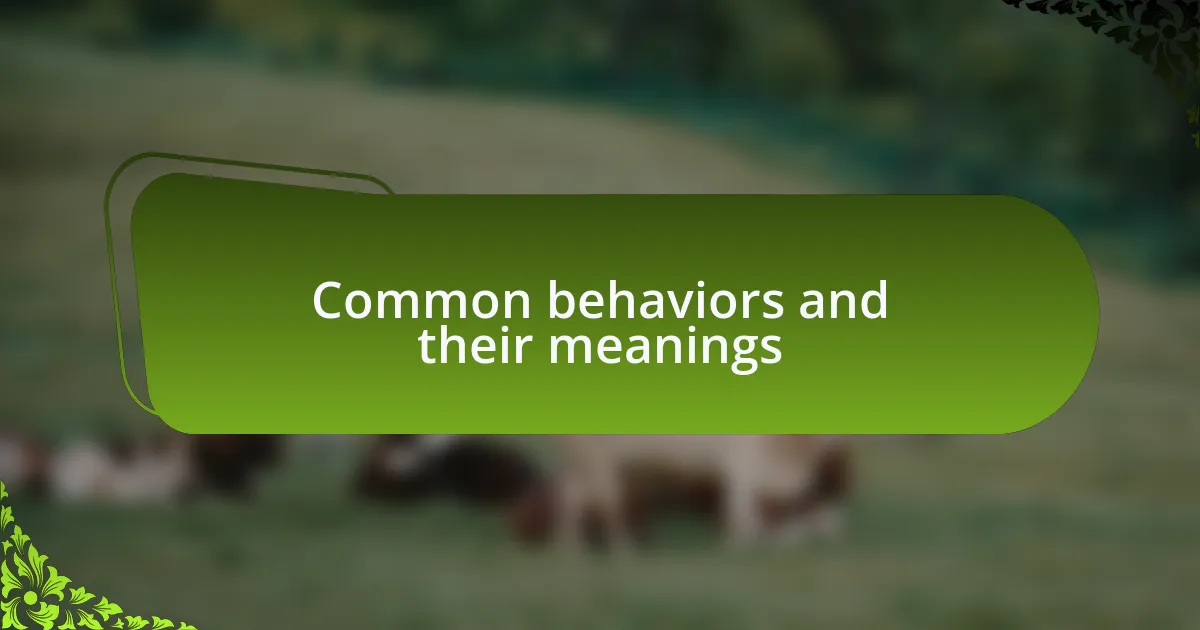
Common behaviors and their meanings
Horses exhibit a range of behaviors that reveal their emotional state, and understanding these can enhance our interactions. For instance, when a horse stands with its head low and relaxed, it typically conveys calmness and comfort. I recall a day at the barn when a young pony was approached by a new rider; his relaxed demeanor and softly flicking ears signaled that he was open to interaction, which eased the rider’s nerves and ultimately led to a positive experience.
On the other hand, a horse that suddenly lifts its head high and pricks its ears forward may be signaling alertness or curiosity. I remember witnessing a stunning gelding at the showgrounds who perked up as he caught sight of a passing group of spectators. His body language shifted, and I realized he was intrigued, perhaps hoping for attention or a treat. Have you ever noticed how your horse reacts to something new in the environment? Recognizing these little changes can turn our understanding of a horse’s mood from guesswork into an informed conversation.
Moreover, aggressive behaviors like biting or kicking often stem from anxiety or fear. There was a time when I misinterpreted a horse’s aggressive stance as mere stubbornness, but a closer look revealed he was overwhelmed by the noise around him. Understanding that aggression often masks fear allowed me to approach him more gently, ultimately leading to a more trusting bond. It makes me wonder—how often do we jump to conclusions about our horses without considering the emotions driving their behaviors? A willingness to look deeper can transform our communication with these incredible animals.
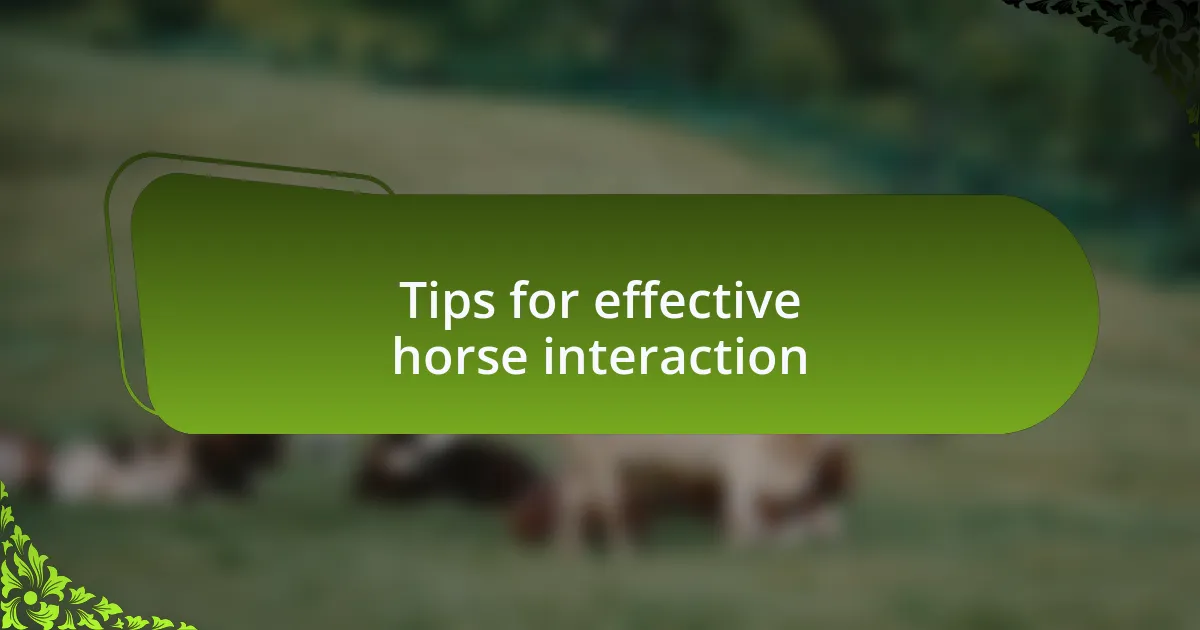
Tips for effective horse interaction
One of the most effective ways to interact with a horse is to remain calm and present. I learned this during a lesson with a nervous mare, who seemed to mirror my own tension. By taking a deep breath and softening my posture, I noticed her body language shift; she began to exhale and relax alongside me. Have you ever considered how your emotional state might influence your horse’s behavior? It’s a powerful reminder that our energy can create a bridge or a barrier.
Another vital tip is to approach a horse at their level, both physically and emotionally. I recall crouching down to meet a young filly’s gaze when she seemed unsure about my presence. By getting down to her eye level and speaking softly, I saw her curiosity peek through her apprehension. This simple act of humility deepened our connection and turned a potential standoff into a moment of trust. How often do we forget the importance of making our horses feel safe and understood?
Lastly, consistent routines can enhance your horse’s sense of security and communication. After years of riding different horses, I’ve come to appreciate how they thrive on predictability. One afternoon, I saw how a mare responded positively to a structured grooming routine I introduced—she stood quietly, eyes soft, as if she knew what to expect next. Isn’t it fascinating how a little consistency can open the door to more profound interactions? Establishing reliable patterns not only builds trust but also makes communication smoother and more effective.
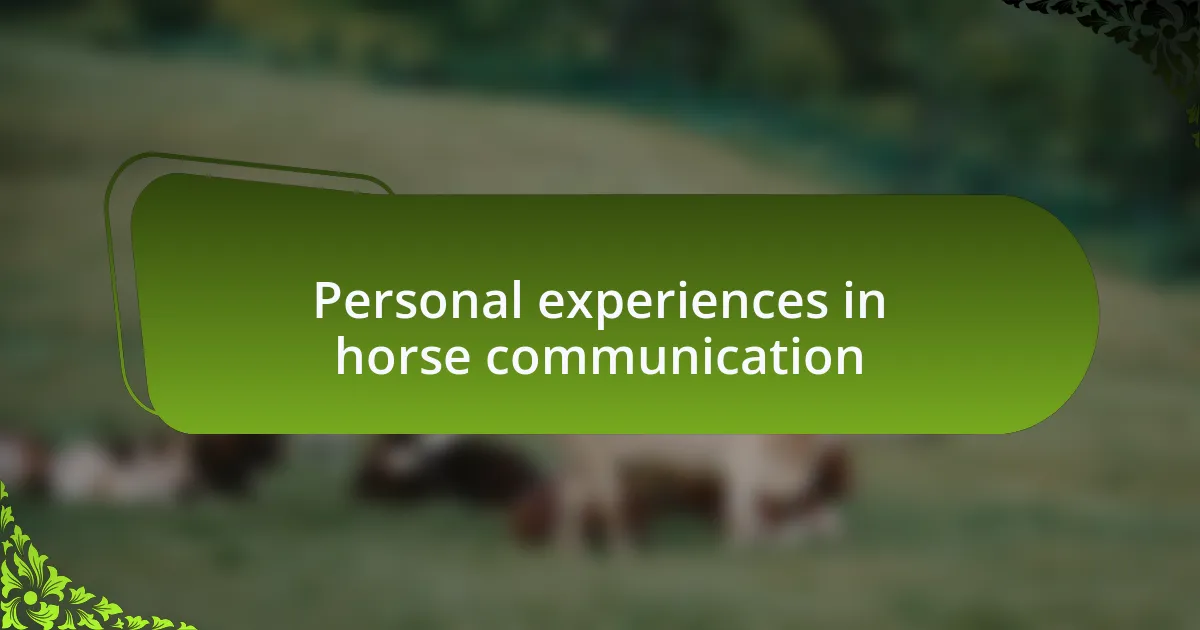
Personal experiences in horse communication
There was a moment when I found myself in a pasture with a typically aloof gelding. I was hesitant, standing at a distance, but as I slowly approached with an open heart and calm energy, he suddenly turned to face me. His ears perked up, and I could almost hear the question in his eyes: “Are you here to connect?” That experience sparked my realization that horses are always seeking connection; it’s up to us to initiate it through our energy and intentions.
Another time, during a rainy day, I learned just how communicative horses can be through subtle gestures. While leading my mare through the barn, she stopped suddenly, lifting her head and pointing her ears toward a clattering noise in the distance. Instead of pushing her forward, I paused and watched her reaction closely. In that moment, I understood that her alertness was her way of saying, “I need you to acknowledge what I’m feeling.” It’s incredible how attuned they are to their surroundings and how important it is for us to listen.
I still remember a bittersweet farewell with a horse I had spent years training. As I prepared to leave, he approached me and gently nudged my shoulder, a silent plea for one last moment together. That nudge brought tears to my eyes; it was as if he was expressing gratitude and longing at once. Have you ever felt that profound connection? It drives home the idea that our communication goes beyond words—it’s the unspoken bond we cultivate through shared experiences and deep understanding.
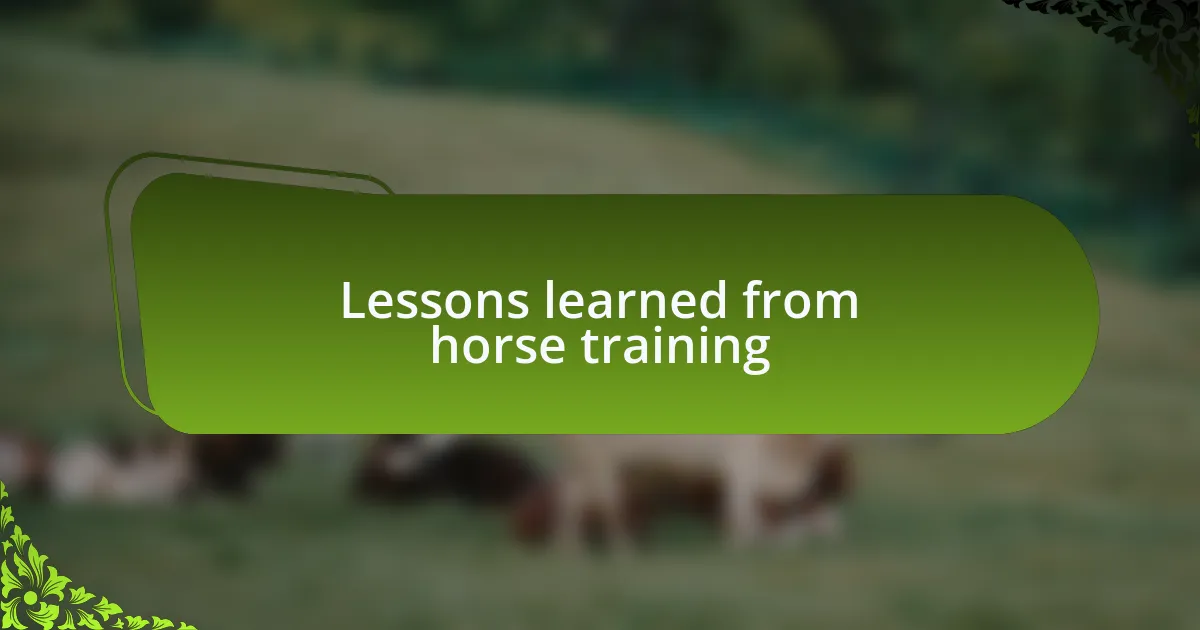
Lessons learned from horse training
While training a spirited mare, I discovered that patience is key. One afternoon, after several failed attempts to get her to canter, I remembered to give her space and time. I stepped back and let her explore her surroundings, and in that moment of calm, she approached me, ready to try again. This taught me that sometimes, stepping back can be more effective than pushing forward.
I once faced a situation that tested my understanding of trust. During groundwork, my horse hesitated near a jump, clearly unsure of it. Instead of insisting he proceed, I knelt beside him, allowing the moment to breathe. By showing him that I was there without pressure, he eventually took a bold step forward. That moment was not just about overcoming an obstacle; it was about building a foundation of trust that transformed our relationship.
On another occasion, I realized that clear communication isn’t just about what we say or do; it’s about what we feel. While teaching my gelding to respond to my body language, I accidentally tensed in anticipation of his next move. He felt this change and stopped, looking back at me with confusion. In that split second, I learned that our emotions are woven into every interaction, highlighting the need to be mindful of our energy when working with horses. How often do we forget this simple truth?
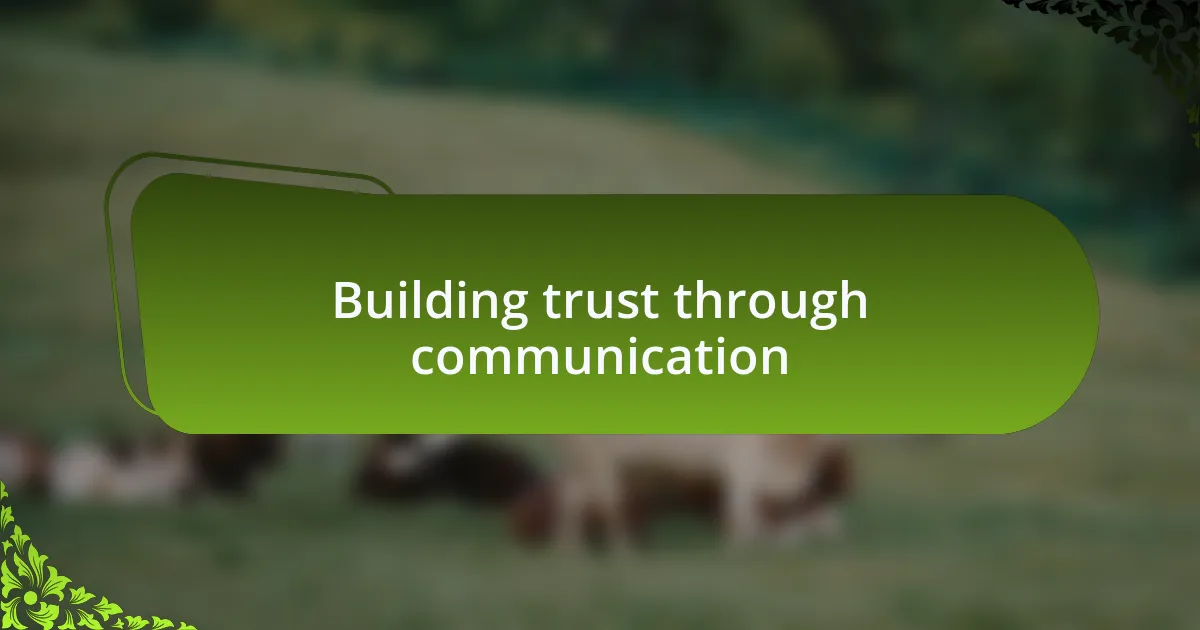
Building trust through communication
One day, I found myself in the arena, feeling frustrated with my horse’s reluctance to move forward. Instead of pushing him harder, I took a deep breath and dropped the tension in my shoulders. When I softened my approach, he mirrored my calmness, making it clear that trust flourishes in an environment free of stress.
During another training session, I tried to encourage my horse to cross a shallow water obstacle. Realizing he was uncertain, I chose to lead by example and stepped into the water myself. Watching me, he hesitated for a moment, then followed. That experience solidified my belief that building trust is a reciprocal journey; when we show vulnerability, they often respond in kind.
Reflecting on these interactions, I often wonder: how many opportunities do we miss to build deeper connections with our equine companions? Each time we communicate, we have the chance to either reinforce trust or create barriers. In my experience, I have learned that by prioritizing understanding and empathy, we strengthen that essential bond, setting the stage for a harmonious partnership.